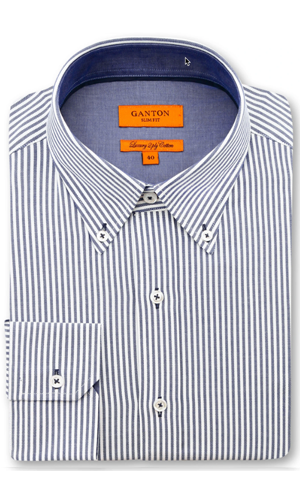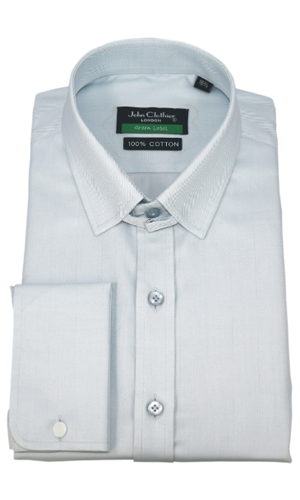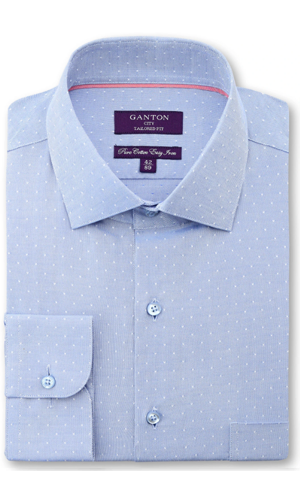Dress: Collars
Your shirt plays a vital role in the success or failure of your professional image.
The shirt resides within an area called the ‘vital V'. This ‘V' extends from your shoulder edge to where the shirt disappears under the lapels. This area is always noticed because as it is in the central line of vision when someone is in front of you and it attracts attention due to the difference in colour and texture between your shirt, tie and jacket. Even minor faults within this area will be quickly noticed. Therefore everything within it requires meticulous attention to detail.
Men have worn dress shirts as far back as the late 1700s, but it was the 1800s that granted them one last outburst of glamour before they succumbed to the drab uniforms of the 1900s. Up to the 1850s, men's shirts were festooned with ruffles both in the front and around the cuffs. In the early 1800s, shirts sported collars that rose to just below the ears and spread open only enough to see the mouth and were worn with wide starched cravats. The 1840s saw several varieties of collars, all moderately high and stiff. The ‘Admiral' had its tips turned down to form wings, the ‘Court' was folded in half and the ‘Whitehall' stood erect. Most were accompanied with either a wide or very thin cravat or a bow tie.
In 1872, women breathed a collective sigh of relief when the detachable collar was invented. Finally, collars could be removed and laundered separately and then replaced with the help of a few small ties. There were even disposable paper versions on the market with printed stitching for the forward-thinking man. Detachable collars remained popular until World War I when returning servicemen (who had lived in soft collared shirts for a couple of years) refused en masse to go back to their prewar stiff collars, so the detachable collar disappeared forever.
In the nineteenth century, shirts, in general, were ill-fitting and often uncomfortable. Mass-produced, they came in only 3 neck sizes: 14, 15 and 16 inches. The sleeves were one size - ‘long' and armbands were used to hold the cuffs suitably in place. During the twentieth century, innovations in fabric technology and design brought many changes to the shirt. In 1920, John Manning Van Heusen introduced the semi-stiff collar. In 1928, Cluett Peabody & Co invented the amortizing process which prevented shirts from shrinking when laundered. The 1950s saw the introduction of the polyester-blend shirt which substantially lowered their cost.
The twenty-first century has seen the dress shirt liberate men with an unending variety of colours and patterns allowing every man to make a personal style statement. Classic colours such as white and light blue will always be the most business-like.
While polyester still plays a significant role, men who prefer comfort and fine quality buy only 100% cotton shirts. Pure cotton is best because allows the fabric to breathe, conforms to the body and responds best to dyes which gives the fabric a richness and clarity that cannot be duplicated (as yet) by blends. If you do buy blend shirts, look for around 5 per cent polyester, rayon, silk or other synthetic, and 95 per cent natural fiber.
This is just enough to prevent wrinkling and increase durability without detracting from the look of the shirt.
To many men's surprise, there are at least 6 distinct collar styles found on shirts. Each has its own history and is complementary to a particular set of facial characteristics, tie knots and suit styles. A man who has a thick neck and/or a round face will find that a round or spread collar will leave him looking as if he has been stuffed into his shirt, while a wide spread or high collar will make a fine-featured man's head appear too small for his body. Men who have a long or thin neck require high collar stands, while those with a short or thick neck will look better with collars that lie flat.
The perfect collar forms an upside-down ‘V', with the edges of the collar meeting at the throat and the points touching the shirt front. The width of the inverted ‘V' should be sufficient to support the width of a tie knot. The fabric of the tie and the width of the suit's lapel will determine the style of knot to be used. Fine fabric ties may need to be tied using a full or half Windsor knot to ensure they do not look too insignificant and disproportionate in comparison with the size of the collar and the collar's V opening.
Finally, collars should fit well. Shirt manufacturers allow for about 2.5 per cent total shrinkage from laundering, so make sure your collars are a little on the large size when you buy them. After being worn for a few hours, tight shirt collars have been proven to cause headaches, impair vision and dull the mind because they press against the carotid arteries of the neck, blocking blood flow to the brain.
Another important area of the shirt is the sleeves. If you want to remain credible as a professional, never be tempted to wear a short-sleeve shirt with a suit or jacket. Short-sleeved business shirts should be teamed solely with sports trousers and worn only in the most casual rural work environments, and never with a tie. Almost all business offices these days are air-conditioned; even if you live in an equatorial region you will need to wear long-sleeved shirts to work if you intend to wear a jacket any length of time. If you do feel the heat when wearing long-sleeved business shirts, roll your sleeves up to just under the elbow. Rolling them to above the elbow instantly changes your image from ‘serious professional hard at work' to someone who looks like they belong on the loading dock. Finally, remember to unroll and button your shirt cuffs before putting on your jacket.






